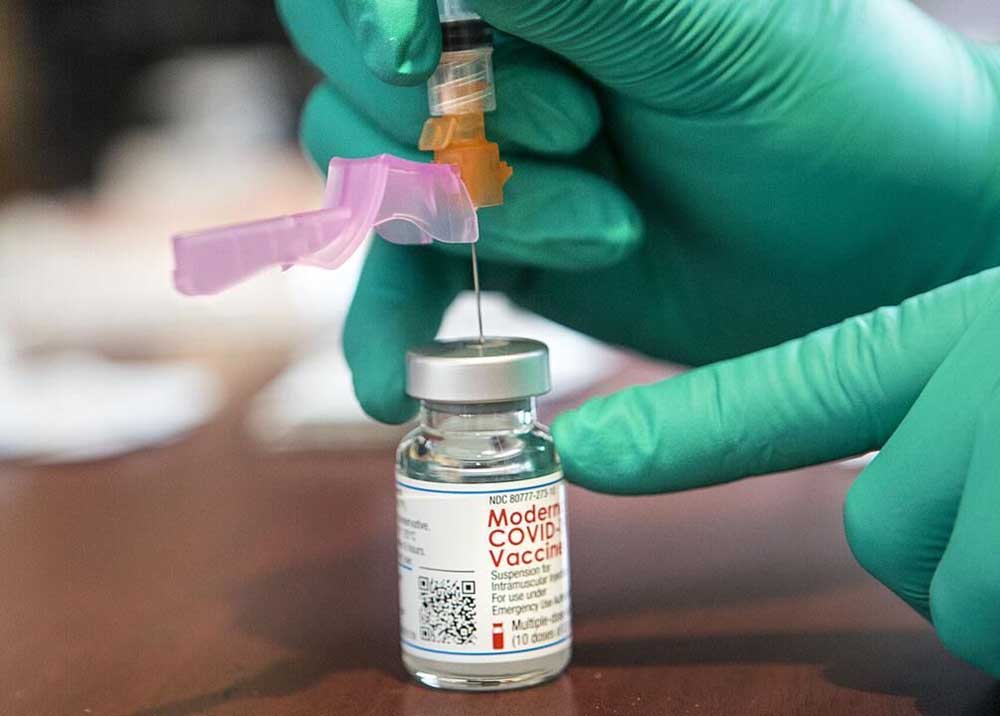New omicron variant drives up COVID-19 reinfection
Published 5:43 pm Wednesday, July 13, 2022

- Kerry Gillette, a physician assistant with Mosaic Medical, fills syringes with the Moderna vaccine during a COVID-19 vaccination clinic at Bethlehem Inn in Bend on Friday, Feb. 19, 2021.
The BA.5 omicron variant has swept into Oregon to become the dominant strain of the coronavirus and increasing the risk of reinfection.
The Oregon Health Authority confirmed late Tuesday that BA.5 accounted for the largest share of new infections.
It also has a higher likelihood of being able to get past vaccinations or immunity due to exposure to previous infections.
Officials said waning protection from vaccinations and earlier infections were resulting in breakthrough cases and second bouts of COVID-19.
“Community-level immunity has decreased since the early Omicron surge last winter,” Dr. Melissa Sutton, who leads the state’s efforts on respiratory viral pathogens, said in a statement. “Immunity from a COVID-19 infection may only last a few months.”
The health authority reported last week that about 56% of new infections were in people who had at least one shot of a vaccine. Unvaccinated people have a far higher likelihood of severe illness and death.
Since the pandemic began in late December 2019, 6.3 million people worldwide have died, including over 1 million in the United States and 7,884 in Oregon.
As of last week, 423 people were in the hospital with COVID-19, the health authority reported. Statistics for this week were not released as of late Wednesday.
The number of hospitalizations includes both patients who came to the hospital because they were sick with COVID-19 and “incidental” cases of people who were in the hospital for other reasons but tested positive for the virus. Oregon Health & Science University’s most recent forecast, issued July 7, projected hospitalizations would peak at about 479 on Tuesday.
Severe cases will gradually decline, falling back to levels under 200 by mid-August and returning to the lows seen in April by Sept. 1, the report said.
Dr. Peter Graven, OHSU’s chief COVID-19 forecaster, said the current rise in infections is the seventh wave of COVID-19 since the virus appeared in Oregon in late February 2020.
The coronavirus has shown an unceasing ability to morph over the 30 months since it first broke out in Wuhan, China.
Researchers say it is too early to determine if BA.5 and the less common new variant, BA. 4, will behave like previous omicron variants that spread faster and wider than any version of the virus seen during the pandemic, but were relatively less virulent, especially for those who are vaccinated and had booster shots.
While individual outcomes are less severe, the sheer number of cases caused by the ever-more-rapidly spreading omicron variants can hit an already overstressed health care system.
Deaths fell sharply in Oregon until early April when they started to climb again.
Fatalities in the state from the virus echo trends around the country. The seven-day average for daily deaths in the U.S. was up 26% over the past 14 days, to 489 on July 12.
For people in Oregon who are vaccinated and had boosters, the chances of severe illness from omicron variants are 2% and death 0.6%.
The wider spread of omicron variants, the sometimes milder symptoms, and increased use of home testing make counting new infections difficult.
“We know that we’re only detecting a small fraction of cases overall,” said Sutton, the OHA official.
Analysis of wastewater has become a more reliable gauge of the presence of the virus in a community. The percentage of tests that come back positive also gives a snapshot of the level of community spread.
Test positivity as of July 11 was 14.6%. OHA officials have said throughout the pandemic that a positive test rate under 5% indicates a level of contagion that health officials can manage.
Breakthrough cases
The Oregon Health Authority’s most recent update on COVID-19 cases, released July 7, showed 45,843 reported cases of COVID-19 infection during the month of June.
The majority of cases — 25,907, or 56.5% — were vaccine breakthrough cases in people who had some level of vaccination. Fully vaccinated and boosted people made up 41.1%.
Unvaccinated people accounted for 19,923, or 43.5%, of cases in June.
More than 80% of Oregonians eligible for inoculation have had at least one dose of the vaccine.
Residents who are fully vaccinated and have received booster shots as recommended by the CDC make up just over 47% of the population.
Since the beginning of the pandemic in Oregon in February 2020, OHA has reported 259,450 COVID-19 vaccine breakthrough cases in Oregon. Of those cases, 78,313, or 30.2%, were fully vaccinated and boosted at the time of infection.
Just 2.6% of all vaccine breakthrough cases have required hospitalization and 0.6% have died. The median age of vaccinated people who died is 80.
The Centers for Disease Control and Prevention currently recommends a COVID-19 vaccination for everyone age 6 months or older. Boosters are recommended for those age 5 and older.








